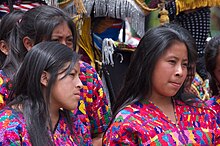மாயா மக்கள்
 பாரம்பரிய உடையில் இளம் மாயா பெண்கள், ஆன்டிகுவா, குவாத்தமாலா | |
| மொத்த மக்கள்தொகை | |
|---|---|
| அண். 8 மில்லியன்+ (2018) முன்-கொலம்பியக் காலம்: 5–10 மில்லியன்[1][2] | |
| குறிப்பிடத்தக்க மக்கள்தொகை கொண்ட பகுதிகள் | |
| நவீன நாடுகளின் பகுதிகளான குவாத்தமாலா, மெக்சிக்கோ, அமெரிக்க ஐக்கிய நாடுகள், பெலீசு, ஒண்டுராசு, மற்றும் எல் சால்வடோர் | |
| 7,140,503 (2018)[3] | |
| 1,475,575 (2000)[4] | |
| 500,000 (2011)[5][6] | |
| 30,107 (2010)[7][8] | |
| 33,256 (2013)[9] | |
| மொழி(கள்) | |
| மாயன் மொழிகள், ஆங்கிலம், எசுப்பானியம், மற்றும் கிரியோல் | |
| சமயங்கள் | |
| கிறிஸ்தவம் மற்றும் மாயா சமயம் | |

மாயா ( Maya) என்பது மெசோஅமெரிக்காவின் பழங்குடி மக்களின் இன மொழியியல் குழுவாகும். பண்டைய மாயா நாகரிகம் இந்த குழுவின் உறுப்பினர்களால் உருவாக்கப்பட்டது. இன்றைய மாயாக்கள் பொதுவாக அந்த வரலாற்று பிராந்தியத்தில் வாழ்ந்த மக்களிடமிருந்து வந்தவர்கள். இன்று இவர்கள் தெற்கு மெக்சிக்கோ, குவாத்தமாலா, பெலீசு, எல் சால்வடோர், நிக்கராகுவா மற்றும் ஒண்டுராசு ஆகிய நாடுகளில் வசிக்கின்றனர்.
"மாயா" என்பது பிராந்தியத்தின் மக்களுக்கான நவீன கூட்டுச் சொல்; இருப்பினும், இந்த வார்த்தை வரலாற்று ரீதியாக பழங்குடி மக்களால் பயன்படுத்தப்படவில்லை. தனித்தனி மக்கள், சமூகங்கள் மற்றும் இனக்குழுக்களிடையே பொதுவான அடையாளமோ அல்லது அரசியல் ஒற்றுமையோ இல்லை. ஏனெனில் அவர்கள் ஒவ்வொருவரும் தங்கள் சொந்த குறிப்பிட்ட மரபுகள், கலாச்சாரங்கள் மற்றும் வரலாற்று அடையாளங்களைக் கொண்டிருந்தனர். [10]
21 ஆம் நூற்றாண்டின் தொடக்கத்தில் ஏழு மில்லியன் மாயாக்கள் இந்த பகுதியில் வாழ்ந்ததாக மதிப்பிடப்பட்டுள்ளது. [1] குவாத்தமாலா, தெற்கு மெக்ஸிகோ மற்றும் யுகடான் தீபகற்பம், பெலீசு, எல் சால்வடோர் மற்றும் மேற்கு ஒண்டுராசு ஆகியவை தங்கள் பண்டைய கலாச்சார பாரம்பரியத்தின் ஏராளமான எச்சங்களை பராமரிக்க முடிந்தது. சிலர் தாங்கள் வசிக்கும் நாடுகளின் பெரும்பான்மையான ஹிஸ்பானியம் செய்யப்பட்ட மெஸ்டிசோ கலாச்சாரங்களுடன் ஒருங்கிணைக்கப்படுகிறார்கள்.[11] மற்றவர்கள் மிகவும் பாரம்பரியமான, கலாச்சார ரீதியாக வேறுபட்ட வாழ்க்கையைத் தொடர்கின்றனர். பெரும்பாலும் மாயன் மொழிகளில் ஒன்றை முதன்மை மொழியாகப் பேசுகிறார்கள்.[12]
சமகால மாயாக்களின் மிகப்பெரிய மக்கள்தொகை குவாத்தமாலா, பெலீசு மற்றும் ஓண்டுராசு மற்றும் எல் சால்வடாரின் மேற்குப் பகுதிகளிலும், மெக்சிகன் மாநிலங்களான யுகடான், காம்பெச்சே, குயின்டானா ரூ, தபாஸ்கோ மற்றும் சியாபாஸ் ஆகியவற்றில் பெரும் பகுதியினரும் வாழ்கின்றனர்.
இதனையும் காண்க[தொகு]
குறிப்புகள்[தொகு]
- ↑ 1.0 1.1 Lorenzo Ochoa; Patricia Martel(dir.) (2002) (in es). Lengua y cultura mayas. UNAM. பக். 170. பன்னாட்டுத் தரப்புத்தக எண்:9703200893. "El "Pueblo Maya" lo constituyen actualmente algo menos de 6 millones de hablantes de 25 idiomas"
- ↑ Nations, James D. (1 January 2010). The Maya Tropical Forest: People, Parks, and Ancient Cities. University of Texas Press. பன்னாட்டுத் தரப்புத்தக எண்:978-0-292-77877-1. https://books.google.com/books?id=naZdAAAAQBAJ.
- ↑ Resultados Del Censo 2018
- ↑ "Comisión Nacional para el Desarrollo de los Pueblos Indígenas. México". Cdi.gob.mx. பார்க்கப்பட்ட நாள் 2013-04-22.
- ↑ "Living Across Borders: Guatemala Maya Immigrants in the US South".
- ↑ "Maya in the US – the Maya Heritage Community Project (By Alan LeBaron, PHD)". July 2018.
- ↑ UN Demographic Yearbooks
- ↑ "Archived copy" (PDF). Archived from the original (PDF) on 2011-08-12. பார்க்கப்பட்ட நாள் 2012-06-07.
{{cite web}}: CS1 maint: archived copy as title (link) - ↑ "Honduras - World Directory of Minorities & Indigenous Peoples". Minority Rights Group (in பிரிட்டிஷ் ஆங்கிலம்). 2015-06-19. பார்க்கப்பட்ட நாள் 2022-10-20.
- ↑ Restall, Matthew (2007). Invading Guatemala : Spanish, Nahua, and Maya Accounts of the Conquest Wars. Pennsylvania State University Press. பன்னாட்டுத் தரப்புத்தக எண்:9780271027586.
- ↑ Castañeda, Quetzil E. (7 May 2008). "'We Are Not Indigenous!': An Introduction to the Maya Identity of Yucatan". Journal of Latin American Anthropology 9 (1): 36–63. doi:10.1525/jlca.2004.9.1.36.
- ↑ OSEA, Open School of Ethnography and Anthropology. "Maya or Mayans? On Correct Use of Terms". பார்க்கப்பட்ட நாள் 2 May 2011. Lincoln, Charles E., Ethnicity and Social Organization at Chichen Itza, Yucatan, Mexico. (PhD. dissertation, Department of Anthropology, Harvard University) Advisors Mathews, Peter, and Gordon R. Willey. (1990). See. Lincoln, Charles E., The Chronology of Chichen Itza: A Review of the Literature. In Late Lowland Maya Civilization: Classic to Postclassic, edited by Jeremy A. Sabloff and E. Wyllys Andrews V, pp. 141-156. Albuquerque: University of New Mexico Press. (1986).
உசாத்துணை[தொகு]
- van Akkeren, Ruud (July 1999). "Sacrifice at the Maize Tree: Rabʼinal Achi in its historical and symbolic context". Ancient Mesoamerica 10 (2): 281–295. doi:10.1017/s0956536199102104.
- Chiappari, Christopher L. (March 2002). "Toward a Maya Theology of Liberation: The Reformulation of a 'Traditional' Religion in the Global Context". Journal for the Scientific Study of Religion 41 (1): 47–67. doi:10.1111/1468-5906.00099. https://archive.org/details/sim_journal-for-the-scientific-study-of-religion_2002-03_41_1/page/47.
- Nikolai Grube (2006). "Maya Today – From Indios Deprived of Rights to the Maya Movement". in Nikolai Grube. Maya: Divine Kings of the Rain Forest. Cologne: Könemann Press. பக். 417–425. பன்னாட்டுத் தரப்புத்தக எண்:3-8331-1957-8. இணையக் கணினி நூலக மையம்:71165439. https://archive.org/details/mayadivinekingso0000unse.
- Mooney, James,
 "Maya Indians". கத்தோலிக்க கலைக்களஞ்சியம் (ஆங்கிலம்). (1913). நியூயார்க்: இராபர்ட் ஆபில்டன் நிறுவனம்.
"Maya Indians". கத்தோலிக்க கலைக்களஞ்சியம் (ஆங்கிலம்). (1913). நியூயார்க்: இராபர்ட் ஆபில்டன் நிறுவனம். - Restall, Matthew (1997). The Maya World. Yucatecan Culture and Society, 1550–1850. Stanford: Stanford University Press. பன்னாட்டுத் தரப்புத்தக எண் 978-0-8047-3658-9.
- Riis-Hansen, Anders (1992). "Interview with Rigoberta Menchu Tum". Commission for the Defense of Human Rights in Central America (CODEHUCA). பார்க்கப்பட்ட நாள் 2006-07-03.
- Kay B. Warren (1998). Indigenous Movements and Their Critics: Pan-Maya Activism in Guatemala. Princeton: Princeton University Press. பன்னாட்டுத் தரப்புத்தக எண்:978-0-691-05882-5. https://archive.org/details/indigenousmoveme0000warr.
மேலும் படிக்க[தொகு]
- Voss, Alexander (2006). "Astronomy and Mathematics". in Nikolai Grube. Maya: Divine Kings of the Rain Forest. Eva Eggebrecht and Matthias Seidel (assistant). Cologne: Könemann. பக். 130–143. பன்னாட்டுத் தரப்புத்தக எண்:3-8331-1957-8. இணையக் கணினி நூலக மையம்:71165439. https://archive.org/details/mayadivinekingso0000unse.
- Wagner, Elizabeth (2006). "Maya Creation Myths and Cosmography". in Nikolai Grube. Maya: Divine Kings of the Rain Forest. Cologne: Könemann. பக். 280–293. பன்னாட்டுத் தரப்புத்தக எண்:3-8331-1957-8. இணையக் கணினி நூலக மையம்:71165439. https://archive.org/details/mayadivinekingso0000unse.
- Castañeda, Xóchitl; Manz, Beatriz; Davenport, Allison (30 June 2017). "Mexicanization: A Survival Strategy for Guatemalan Mayans in the San Francisco Bay Area". Migraciones Internacionales 1 (3): 103–123. doi:10.17428/rmi.v1i3.1285. https://migracionesinternacionales.colef.mx/index.php/migracionesinternacionales/article/view/1285.
- Bazo Vienrich, Alessandra (13 December 2018). "Indigenous Immigrants from Latin America (IILA): Racial/Ethnic Identity in the U.S.". Sociology Compass: e12644. doi:10.1111/soc4.12644.
வெளி இணைப்புகள்[தொகு]
- Brown, William; Odem, Mary (16 February 2011). "Living Across Borders: Guatemala Maya Immigrants in the US South". Southern Spaces. https://southernspaces.org/2011/living-across-borders-guatemala-maya-immigrants-us-south/.

